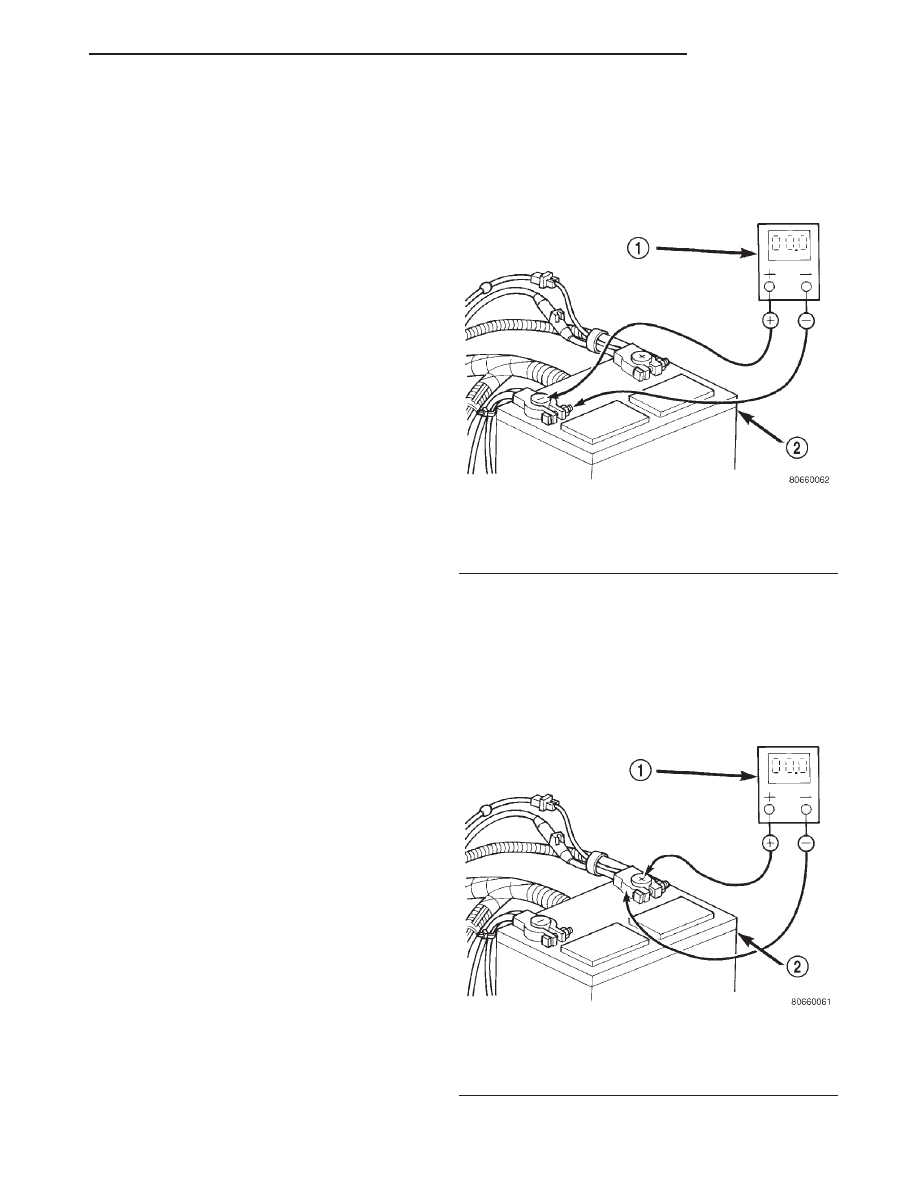Dodge Durango (DN). Manual - part 265

you are reading the combined voltage drop in the
battery positive cable terminal clamp-to-terminal
post connection and the battery positive cable.
TESTING
VOLTAGE DROP TEST
WARNING:
•
IF THE BATTERY SHOWS SIGNS OF FREEZ-
ING, LEAKING, LOOSE POSTS, OR LOW ELECTRO-
LYTE LEVEL, DO NOT TEST, ASSIST-BOOST, OR
CHARGE. THE BATTERY MAY ARC INTERNALLY
AND EXPLODE. PERSONAL INJURY AND/OR VEHI-
CLE DAMAGE MAY RESULT.
•
EXPLOSIVE HYDROGEN GAS FORMS IN AND
AROUND THE BATTERY. DO NOT SMOKE, USE
FLAME, OR CREATE SPARKS NEAR THE BATTERY.
PERSONAL INJURY AND/OR VEHICLE DAMAGE
MAY RESULT.
•
THE BATTERY CONTAINS SULFURIC ACID,
WHICH IS POISONOUS AND CAUSTIC. AVOID CON-
TACT WITH THE SKIN, EYES, OR CLOTHING. IN
THE EVENT OF CONTACT, FLUSH WITH WATER
AND CALL A PHYSICIAN IMMEDIATELY. KEEP OUT
OF THE REACH OF CHILDREN.
•
IF THE BATTERY IS EQUIPPED WITH REMOV-
ABLE CELL CAPS, BE CERTAIN THAT EACH OF
THE CELL CAPS IS IN PLACE AND TIGHT BEFORE
THE BATTERY IS RETURNED TO SERVICE. PER-
SONAL INJURY AND/OR VEHICLE DAMAGE MAY
RESULT FROM LOOSE OR MISSING CELL CAPS.
The following operation will require a voltmeter
accurate to 1/10 (0.10) volt. Before performing this
test, be certain that the following procedures are
accomplished:
• The battery is fully-charged and load tested.
Refer to Battery Charging in the index of this ser-
vice manual for the location of the proper battery
charging procedures. Refer to Battery in the index of
this service manual for the location of the battery
diagnosis
and
testing
procedures,
including
the
proper battery load test procedures.
• Fully engage the parking brake.
• Place the automatic transmission gearshift selec-
tor lever in the Park position.
• Verify that all lamps and accessories are turned
off.
• To prevent the engine from starting, remove the
Automatic ShutDown (ASD) relay. The ASD relay is
located in the Power Distribution Center (PDC), in
the engine compartment. See the fuse and relay lay-
out label affixed to the underside of the PDC cover
for ASD relay identification and location.
(1) Connect the positive lead of the voltmeter to
the battery negative terminal post. Connect the neg-
ative lead of the voltmeter to the battery negative
cable terminal clamp (Fig. 13). Rotate and hold the
ignition switch in the Start position. Observe the
voltmeter. If voltage is detected, correct the poor con-
nection between the battery negative cable terminal
clamp and the battery negative terminal post.
(2) Connect the positive lead of the voltmeter to
the battery positive terminal post. Connect the nega-
tive lead of the voltmeter to the battery positive cable
terminal clamp (Fig. 14). Rotate and hold the ignition
switch in the Start position. Observe the voltmeter. If
voltage is detected, correct the poor connection
between the battery positive cable terminal clamp
and the battery positive terminal post.
Fig. 13 Test Battery Negative Connection
Resistance - Typical
1 – VOLTMETER
2 – BATTERY
Fig. 14 Test Battery Positive Connection Resistance
- Typical
1 – VOLTMETER
2 – BATTERY
DN
BATTERY
8A - 15
DIAGNOSIS AND TESTING (Continued)